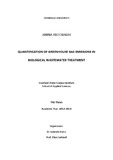JavaScript is disabled for your browser. Some features of this site may not work without it.
| dc.contributor.advisor | Dotro, Gabriela | |
| dc.contributor.advisor | Cartmell, Elise | |
| dc.contributor.author | Aboobakar, Amina | |
| dc.date.accessioned | 2014-06-03T11:52:55Z | |
| dc.date.available | 2014-06-03T11:52:55Z | |
| dc.date.issued | 2014-01 | |
| dc.identifier.uri | http://dspace.lib.cranfield.ac.uk/handle/1826/8494 | |
| dc.description.abstract | There is an increasing need to reduce greenhouse gas (GHG) emissions and to identify influencing factors from wastewater treatment plants (WWTPs), particularly process emissions consisting of nitrous oxide (N2O), and methane (CH4) GHG, with global warming potentials about 310 and 21 times higher than carbon dioxide (CO2) respectively (IPCC, 2006). However, the challenges offered by full-scale environments, have to date, restricted a real-time, comprehensive approach of monitoring emissions and influencing factors. This study aimed at addressing this knowledge gap, by reporting the findings of a long-term, online, continuous monitoring of GHG emissions and operational variables. Lanes were monitored in nitrifying activated sludge plants (ASP) controlled under ammonia (NH4 + ) and dissolved oxygen (DO) set-points (DO setpoints monitored: 1.5 and 2.0 mg/L), as well as in a biological nutrient removal plant (BNR) under NH4 + control. The findings showed that CH4, although potentially formed in non-aerated compartments, was emitted in aerobic zones, at an average emission factor (EF) of 0.07 % of influent and removed chemical oxygen demand (COD). Nitrous oxide EFs on the other hand, depended on relative nitrogen fractions, with influent-based EFs showing a best-case scenario, at 0.05–0.72 % of both influent total nitrogen (TN) and NH4 + , compared to the higher EFs based on removed nitrogen at 0.13–3.9 % of TN and NH4 + removed. The processes operated under the same control settings (DO set-point 1.5 mg/L), had similar, or identical, EF, suggesting that settings could help predict the range of EF. Nitrous oxide was always produced in the presence of NH4 + , even at low concentrations (=<0.5 mg/L), therefore linking N2O production with NH4 + oxidation, particularly with nitrifier nitrification. Incomplete denitrification under low carbon to nitrogen (C/N) ratios also triggered N2O production (EFs of 2.4 and 4.1 % of reduced TN at C/N ratios of 2.8 and 2.4 respectively), particularly with intermittent aeration. Therefore, nitrifier denitrification and incomplete denitrification simultaneously occurred and triggered N2O production in the final stages of nitrification. The BNR lane was the most operationally stable process, therefore offering the best balance between efficiency (60–99 % less aeration and energy per kg of treated NH4 + ), low carbon footprint and reduced EFs (0.08–0.1 % of all nitrogen fractions). The second best option was the DO set-point control of 1.5 mg/L, with low EFs (0.05–0.2 %), stable operational conditions and reduction in aeration requirements (up to 340 % less than DO set-point 2.0 mg/L). Operating ASP under NH4 + control however, led to 7–96 % more efficiency than under DO set-points, although it required better control in the back end of the process. Only an online, long-term methodology such as adopted in this study, could provide insights into emission variability and the effect of operational variables on promoting or reducing emissions. Based on this, strategies to mitigate emissions at full-scale were recommended. | en_UK |
| dc.language.iso | en | en_UK |
| dc.publisher | Cranfield University | en_UK |
| dc.rights | © Cranfield University 2014. All rights reserved. No part of this publication may be reproduced without the written permission of the copyright owner. | en_UK |
| dc.title | Quantification of greenhouse gas emissions in biological wastewater treatment | en_UK |
| dc.type | Thesis or dissertation | en_UK |
| dc.type.qualificationlevel | Doctoral | en_UK |
| dc.type.qualificationname | PhD | en_UK |
